The Ultimate Guide to the Jungfrau Travel Pass [2024/205]
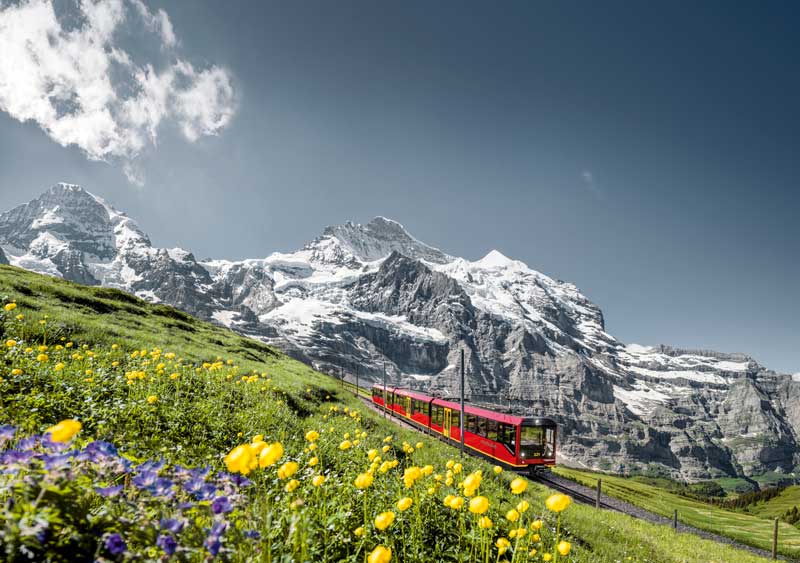
[This post may contain compensated links. Please see my disclosure policy for more information.]
Visiting the Jungfrau mountain aboard the Jungfrau train is a must-do experience but tickets to reach the Jungfraujoch don’t come cheap.
With this in mind, if you have more than one day to spend in the Jungfrau region, you might find it better economically to purchase the Jungfrau Travel Pass which also includes local trains and boat rides and excursions to a number of mountains in the Jungfrau Region.
In short, the Jungfrau Travel Pass includes free travel on:
- Trains from Interlaken Ost to Lauterbrunnen, Grindelwald, Kleine Scheidegg, Eiger Glacier, Interlaken West and Brienz
- Cable car from Lauterbrunnen to Grütschalp
- Train from Grütschalp to Mürren
- Cable car (Eiger Express) from Grindelwald Terminal to Eiger Glacier
- Cable car from Grindelwald to First
- Cable car from Grindelwald Terminal to Männlichen
- Cable car from Wengen to Männlichen
- Cogwheel train from Wilderswil to Schynige Platte
- Funicular from Interlaken to Harder Kulm
- Boats on Lake Thun and Lake Brienz
- Special price for cogwheel train from Eiger Glacier to Jungfraujoch
🇨🇭 NEW VALIDITY: From 5 December, 2024 the Jungfrau Travel Pass will be valid all year round. The 2025 Pass will be available for purchase from approximately the beginning of November 2024.🇨🇭
If you’ve been asking yourself “Is the Jungfrau Travel Pass worth it?“, this guide will provide the answer!
What's in this Article
What is the Jungfrau Travel Pass?
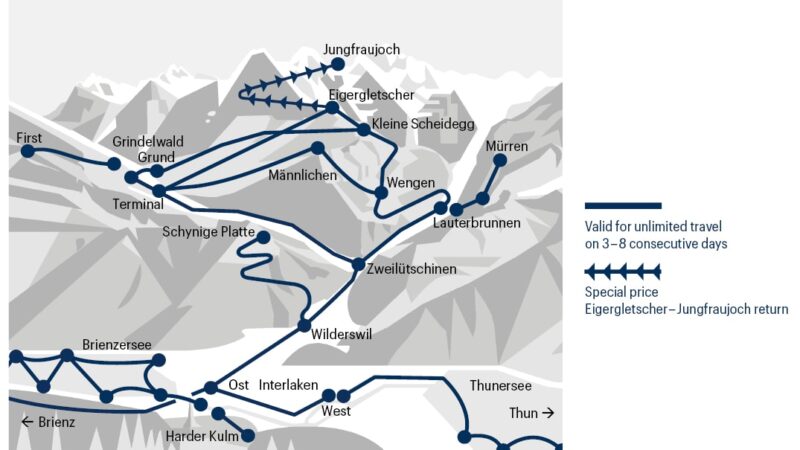
The Jungfrau Travel Pass (sometimes called the Jungfrau Pass, Jungfrau Region Pass or Jungfrau VIP Pass) is an unlimited regional travel pass valid for durations from three to eight days that can take the place of individual Jungfrau tickets. > Click here to check current prices.
The Pass includes travel by train and cable car to some of the top attractions in Switzerland.
The Pass also includes boat cruises on Lake Thun and Lake Brienz. Train travel between Interlaken Ost and West, and Interlaken Ost and Brienz, is also included.
For 2024 the validity period of the Jungfrau Travel Pass has been extended and it will be valid for use from 29 March to 27 October inclusive. From 15 December, 2024, the Jungfrau Travel Pass will be valid for use all year round.
How much does the Jungfrau Travel Pass cost ?
Below you will find the regular prices for the Jungfrau Travel Pass for travel in 2024 and 2025.
Regular adult prices:
- 3 days – CHF 210 per adult – click here to purchase
- 4 days – CHF 235 per adult – click here to purchase
- 5 days – CHF 270 per adult – click here to purchase
- 6 days – CHF 290 – per adult – click here to purchase
- 7 days – CHF 310 – per adult – click here to purchase
- 8 days – CHF 330 – per adult – click here to purchase
Reduced Jungfrau Travel Pass price applies for travellers who also hold a valid Swiss Travel Pass or Swiss Half Fare Card. Prices are as follows:
- 3 days – CHF 165 per adult – click here to purchase
- 4 days – CHF 180 per adult – click here to purchase
- 5 days – CHF 210 per adult – click here to purchase
- 6 days – CHF 225 per adult – click here to purchase
- 7 days – CHF 240 per adult – click here to purchase
- 8 days – CHF 255 per adult – click here to purchase
Children 6 to 15 years pay CHF 30 regardless of number of days travel on Jungfrau Travel Pass but only if their ticket is purchased from a railway station in the region or directly from Jungfrau Railways.
What is included in the Jungfrau Travel Pass?
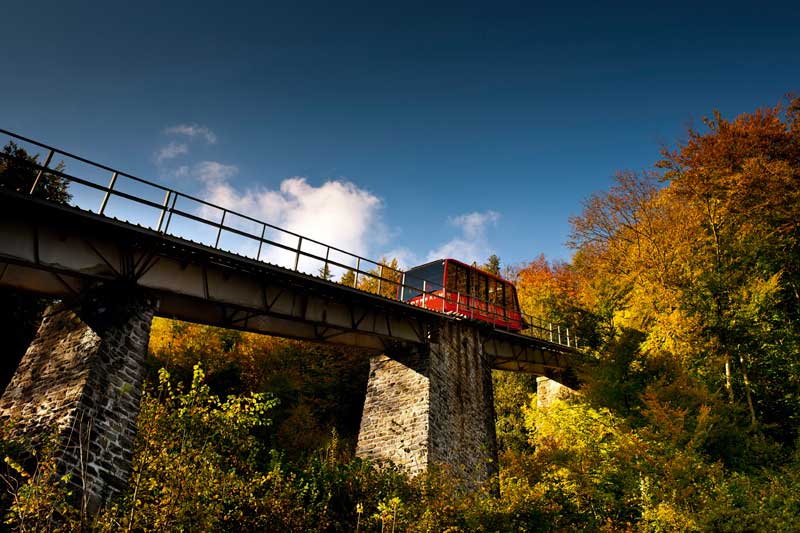
As well as covering travel on most regular trains in the Jungfrau region and boat rides on Lakes Thun and Brienz, the Jungfrau Travel Pass also includes the cogwheel trains from Kleine Scheidegg to Eiger Glacier and from Wilderswil to Schynige Platte and the Harder Kulm funicular.
Gondolas (cable cars) between Grindelwald and First, Wengen and Männlichen, Grindelwald Terminal and Männlichen, Grindelwald Terminal and Eiger Glacier, and Lauterbrunnen and Grütschalp are also included in the Pass.
Also included is the train from Grütschalp to Mürren.
*A supplement applies for the sector from Eigergletscher to Jungfraujoch – see details below.
| Excursion | Regular individual fare (adult) | Included in Jungfrau Travel Pass? |
| Interlaken to Jungfraujoch by train | CHF 249.80^ / CHF 223.80 return | Yes, except for the final leg which costs CHF 75^ / CHF 63 |
| Grindelwald Terminal to Jungfraujoch by Eiger Express and train | CHF 214.00^ / CHF 190.00 return | Yes, except for the final leg which costs CHF 75^ / CHF 63 |
| Interlaken to Harder Kulm | CHF 44.00^ /CHF 38.00 return | Yes |
| Wilderswil to Schynige Platte | CHF 64.00 return | Yes |
| Grindelwald to First | CHF 76.00^/CHF 72.00 return | Yes |
| Wengen to Mannlichen | CHF 48.00 return | Yes |
| Lauterbrunnen to Murren | CHF 23.60 return | Yes |
^ High season – 1 June to 31 August. Note: not all mountain railways operate year round.
> CLICK HERE TO BUY YOUR JUNGFRAU TRAVEL PASS
Below is a brief description of some of the excursions included in the Jungfrau Travel Pass.
Jungfraujoch
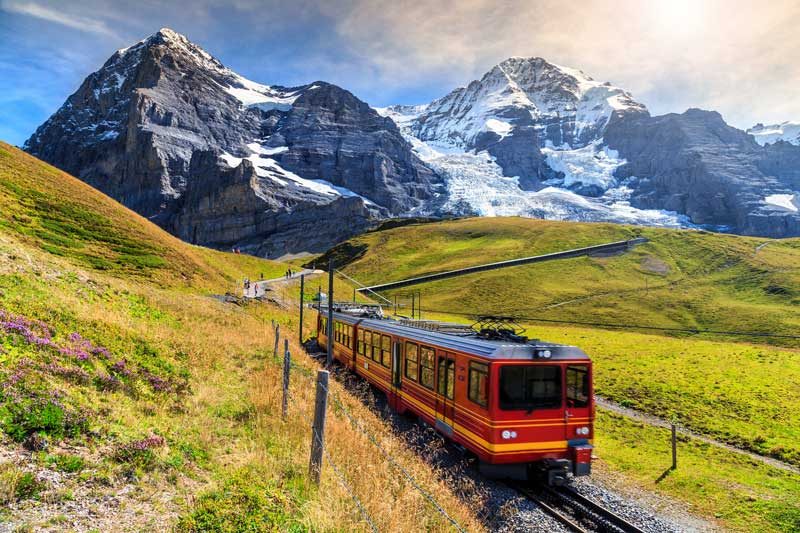
Jungfrau Bahn (train)
Operates: 365 days per year
One of the most famous train rides in Switzerland, the Jungfrau bahn (train) takes visitors to the highest railway station in Europe at 3,454 metres above sea level.
A two-hour journey from Interlaken via a seamless connection of regional trains and the Jungfrau bahn, the trip offers incredible panoramic views.
Passing alongside lush alpine meadows and waterfalls, and through a 7-kilometre long tunnel carved through the mountain, the journey to the summit at Jungfraujoch – Top of Europe, is one you’ll never forget.
The Jungfrau railway was built from 1896 to 1912 and is an engineering masterpiece.
Note: A supplement (or ‘connecting ticket’) is payable for the final leg of the journey from Eiger Glacier to Jungfraujoch. Prices are shown in the table above.
Eiger Express cableway between Grindelwald Terminal and Eiger Glacier
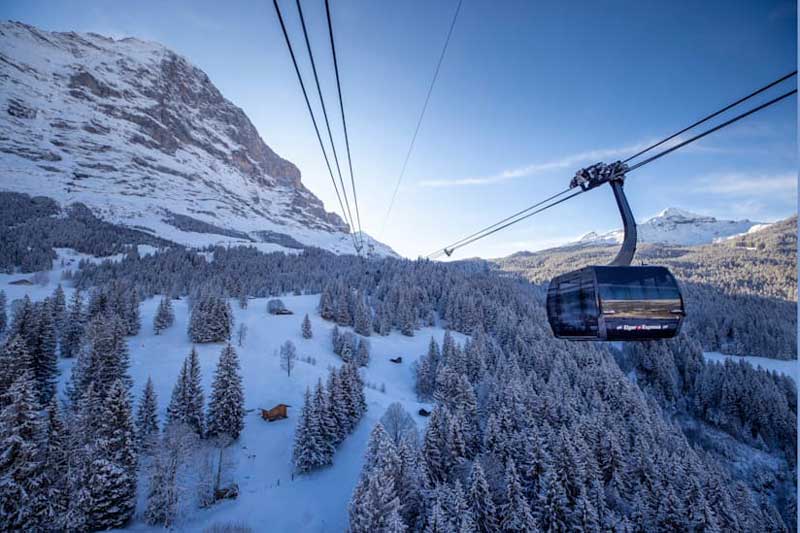
Operates: Year round except for five days in early November
Since December 2020, it is possible to travel to Jungfraujoch using a combination of train and cable car. The Eiger Express cableway travels between Grindelwald and Eiger Glacier in just 15 minutes, 47 minutes faster than the train journey between the two destinations.
At the Eiger Glacier cableway station, passengers can connect seamlessly to the Jungfrau train for the final leg of the journey to Jungfraujoch.
Travel on the Eiger Express is included with the Jungfrau Travel Pass.
Why not travel the entire journey by train in one direction and a combination of train and cableway in the other direction?
You’ll find much more information about the Jungfraujoch excursion including how to get to Jungfraujoch and what to do at Jungfraujoch below.
Note: If you wish to continue on to Jungfraujoch after alighting at Eiger Glacier, a supplement is payable for the train journey from Eiger Glacier to Jungfraujoch. This applies whether you travel the entire journey by train or use a combination of cable car and train. Jungfrau Travel Pass holders can purchase the supplement for CHF 75 return for travel in high season (1 June to 31 August) or CHF 63 return for the remainder of the year.
Grindelwald and First cable car
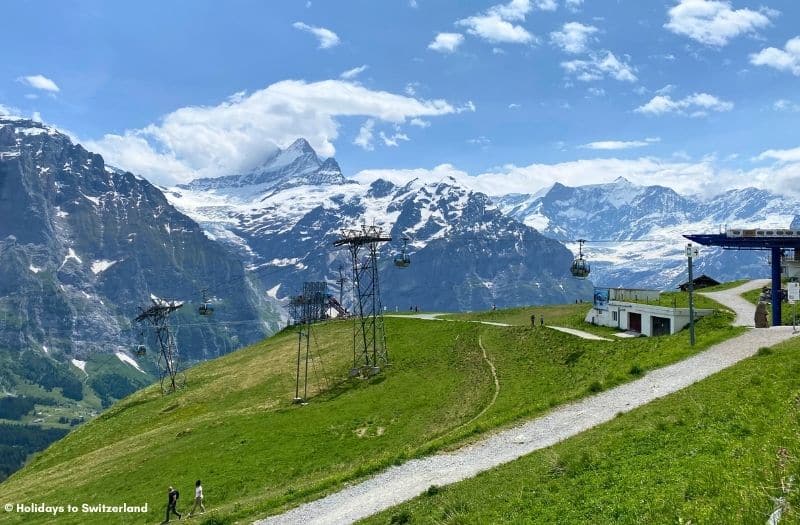
Operates: 15 December 2024 to 26 October, 2025
The Jungfrau Travel Pass includes rail travel from Interlaken to Grindelwald on the Bernese Oberland Railway and the cable car to First mountain.
Tickets for activities at First such as Trottibikes, First Flyer, First Glider, etc. are additional.
Another mountain excursion included from Grindelwald is the cableway from Grindelwald Terminal to Männlichen.
Harder Kulm funicular
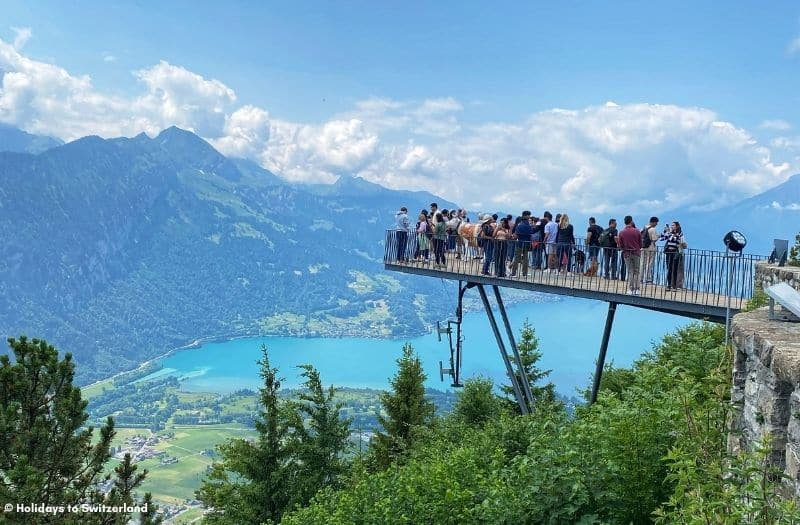
Operates: 29 March to 24 November, 2024 / 5 April to 30 November, 2025
The Harderbahn is a funicular from Interlaken to Harder Kulm. The funicular climbs to 1322 metres above sea level on the 10-minute journey and travels at a gradient of 64%.
With huge windows and a glass roof, the Harderbahn offers superb views of Interlaken.
At the summit, a short walk takes you to the Two Lakes Bridge from where you can see Lakes Thun and Brienz, Interlaken and the nearby peaks of the Eiger, Jungfrau and Monch.
There’s a restaurant which serves traditional Swiss meals, as well as a snack bar
If you’re feeling energetic, the Harder Wanderweg (a circular walking path) takes around an hour to complete.
Schynige Platte cogwheel railway
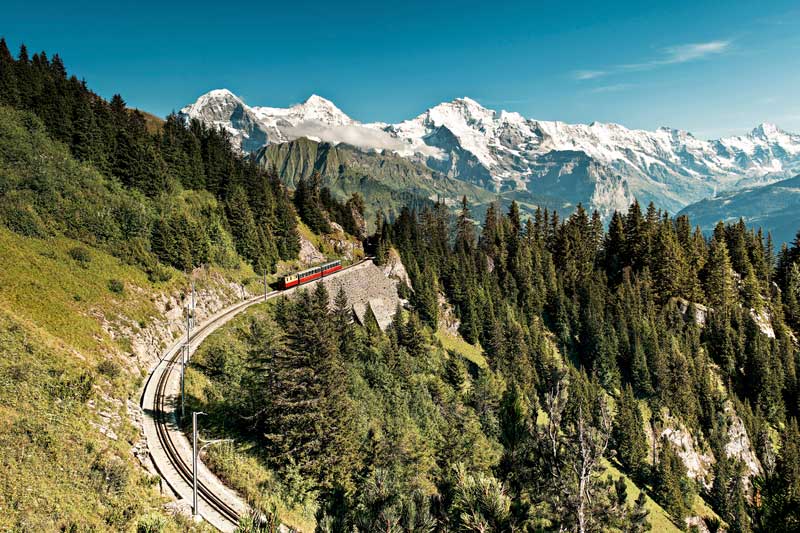
Operates: 15 June to 20 October, 2024 / mid-June to late October, 2025 (dates to be confirmed)
Since 1918 an open-sided cog-wheel railway to Schynige Platte has been operating from Wilderswil, just a few minutes from Interlaken.
Traditional-style carriages with wooden bench seats are still used today on the one-hour journey across the Breitlauenen Alp.
Whilst an electric-powered engine is used today, four times per summer passengers can experience can enjoy a steam-powered ride with the original locomotive built in 1894.
Between 11am and 2pm each day (from 1 June), alphorn players dressed in traditional Swiss costumes perform a free concert. A photo is a must!
Schynige Platte is the starting point for numerous hikes of various lengths.
There is a bistro and a restaurant at Schynige Platte and it’s also possible to stay overnight in the hotel.
Wengen to Männlichen cableway
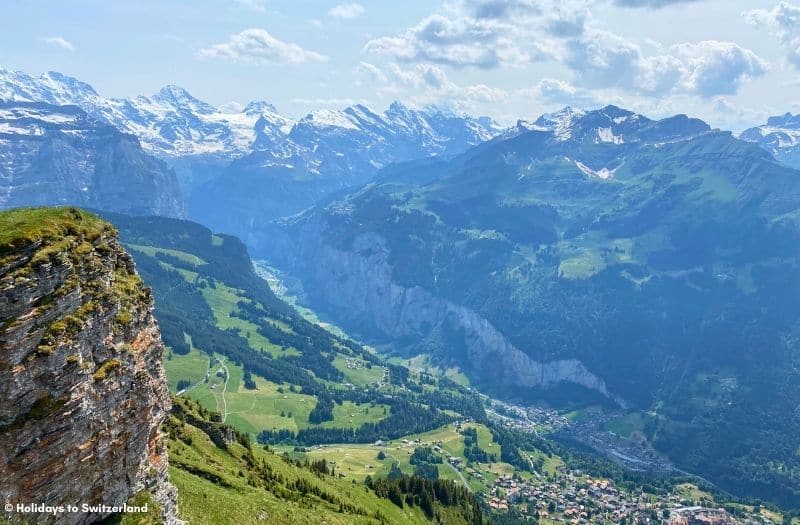
Operates: Year round except 8 April to 24 May, 2024 and mid-October to mid-December, 2024 (dates to be confirmed)
With plenty of alpine walks to enjoy, an adventure playground for children and great views over the Bernese Alps and Lauterbrunnen Valley, a visit to Männlichen makes a great day out.
A popular short hike is the Royal Walk which ends at a viewing platform with breathtaking views. The hiking trail is reasonably steep but you’ll be rewarded with panoramic vistas.
Männlichen can also be reached by cable car from Grindelwald Terminal.
🇨🇭 Read more about visiting Männlichen
Mürrenbahn
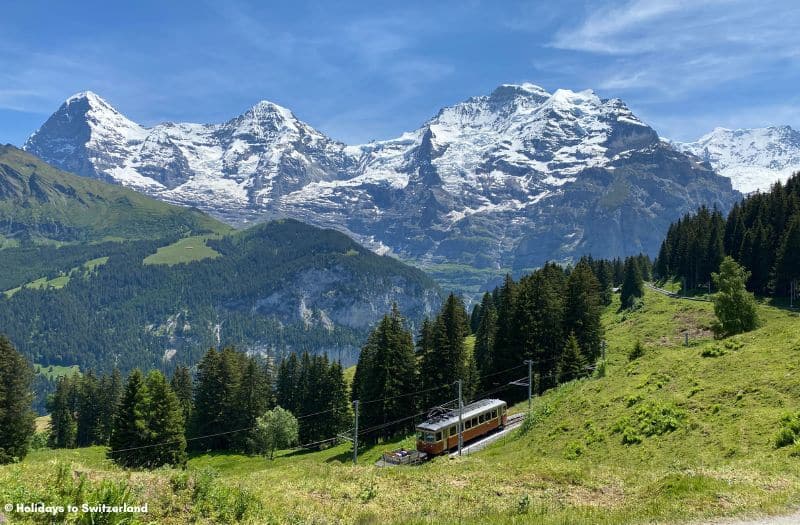
Operates: Year round except for 6 to 31 May and 21 October to 8 November, 2024.
Access to the car-free village of Mürren from Lauterbrunnen includes a combination of cable car and train.
In four minutes, an aerial cable car transports passengers from Lauterbrunnen to Grütschalp, where they connect with a train to Mürren, via Winteregg.
All passengers visiting the Schilthorn travel through Mürren.
Cruises on Lake Thun and Lake Brienz
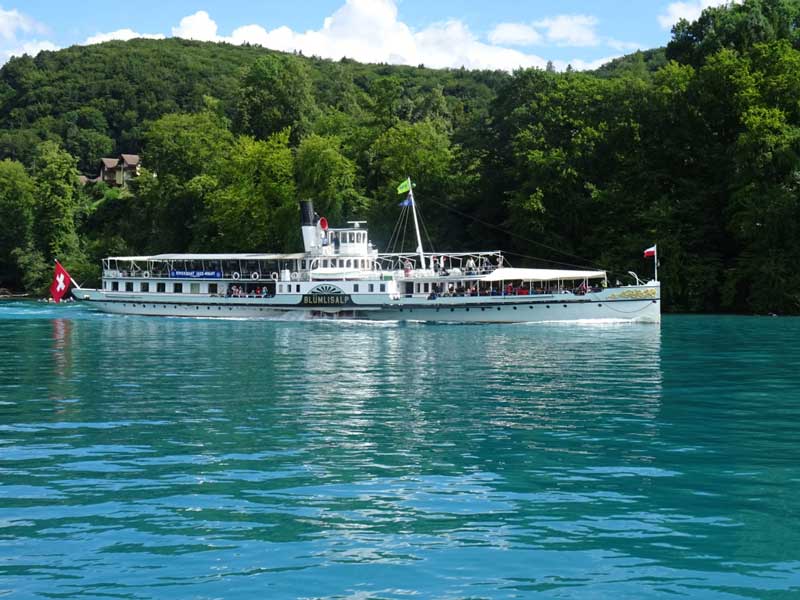
In addition to the above inclusions, passes also include train trips between Interlaken Ost and West stations, and Interlaken Ost and Brienz, as well as boat cruises on Lake Thun and Lake Brienz.
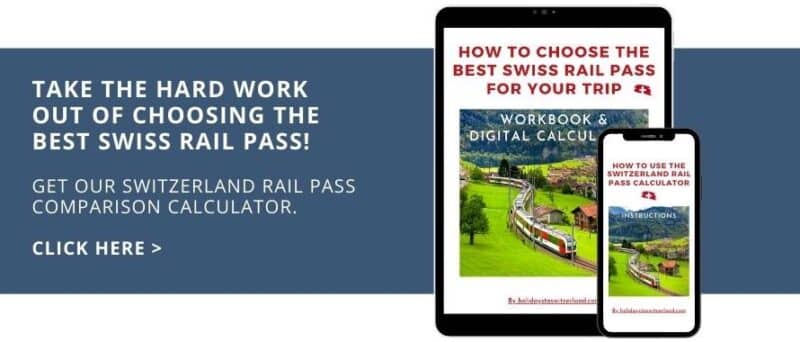
How many days does the Jungfrau Travel Pass last?
The Jungfrau Travel Pass can be purchased in the following durations: – 3 days, 4 days, 5 days, 6 days, 7 days, 8 days.
When is the Jungfrau Travel Pass valid?
The 2024 Jungfrau Travel is available for use from 29 March to 27 October, 2024. The 2025 Jungfrau Travel Pass is valid for use all year round from 5 December, 2024.
Watch our live Q&A session about the Jungfrau Travel Pass here.
Would you like to save this article?
We promise never to spam you.
Do any discounts apply to the Jungfrau Travel Pass?
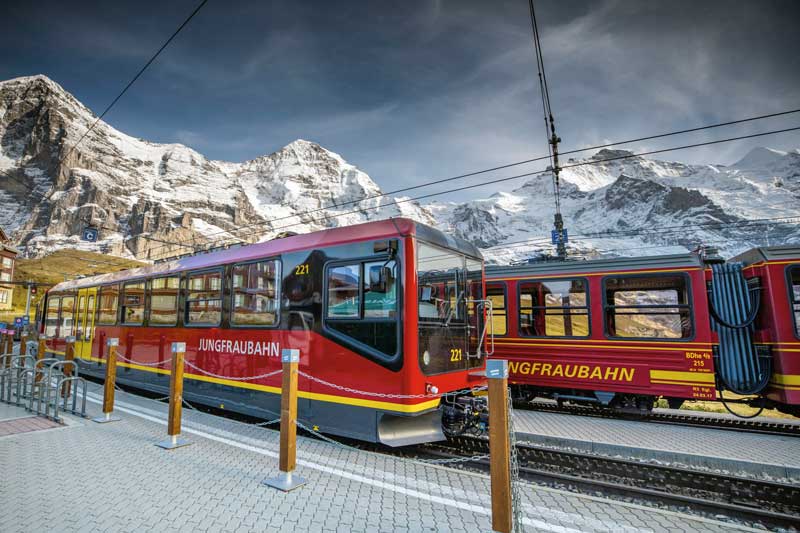
Whilst there are generally no Jungfrau Travel Pass discount codes available, reductions do apply for holders of the Swiss Half Fare Card, Swiss Travel Pass and Swiss Travel Pass Flex.
When purchasing your Jungfrau Travel Pass online, be sure to select the correct option to ensure you pay the discounted price.
Swiss Travel Pass holders and Swiss Half Fare Card holders can buy their discounted Jungfrau Travel Pass on this link.
You will be required to present both your Jungfrau Travel Pass voucher and your Half Fare Card and/or Swiss Travel Pass to the ticket inspector on request.
Buy your Swiss Travel Pass or Swiss Half Fare Card to qualify for the reduced-price Jungfrau Travel Pass.
Does the Jungfrau Travel Pass include train travel all the way to the Jungfraujoch?
Whilst the Jungfrau Travel Pass does not cover the fare all the way to the top of Jungfraujoch, the final sector can be purchased at a specially reduced price.
If you’re wondering how to go to Jungfraujoch on the ‘cheap’, you should consider the pass even though it costs an additional fee as it still may be more economical for you.
The additional ticket for the Jungfraujoch journey should be purchased at Interlaken, Lauterbrunnen, Grindelwald or Kleine Scheidegg railway station prior to your journey.
How do I validate my Jungfrau Travel Pass ticket?
If you have purchased your Jungfrau Travel Pass online, you should print out a copy of the voucher. The voucher/ticket does not need to be validated but should be presented to the ticket inspector on each train when requested.
Please make sure the dates on your voucher correspond to the dates you are travelling.
Do I need a seat reservation on the Jungfraujoch train?
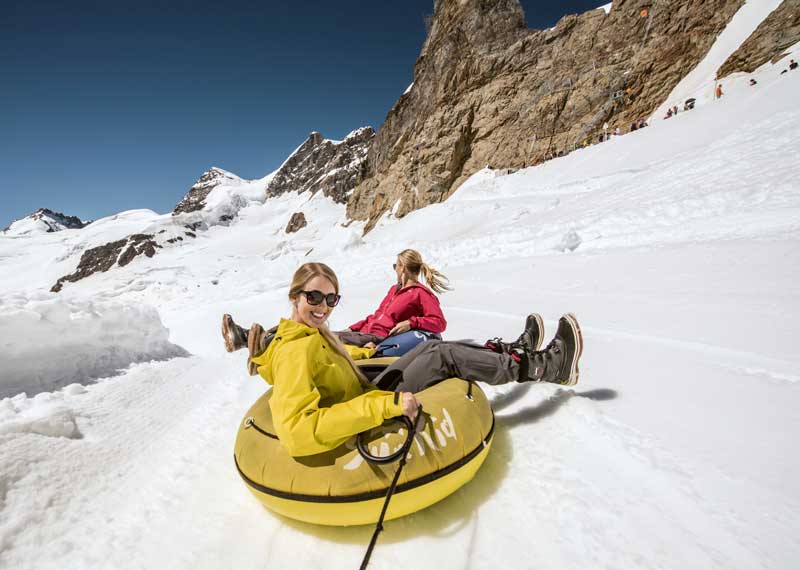
Seat reservations are not compulsory but are highly recommended during high season, particularly in good weather.
Holding a seat reservation allows separate boarding and guarantees a seat on the sector between Kleine Scheidegg and Jungfraujoch and vice versa (about 30 minutes duration each way).
Specific seats are not allocated but a reserved seat is guaranteed.
Jungfrau bahn seat reservations cost CHF 10 per person return.
How long does it take to get from Interlaken to Jungfraujoch?
Both the Interlaken to Jungfraujoch train journey and the Grindelwald to Jungfraujoch train journey takes two hours. This makes a Grindelwald or Interlaken to Jungfrau day trip very easy.
The journey does require a change of trains but the timetables are set so that there is minimal waiting time between trains.
If travelling via Grindelwald you will travel on the Bernese Oberland Railway between Interlaken and Grindelwald. From Grindelwald, the Wengernalp rack railway operates to Kleine Scheidegg, then you transfer to the Jungfraubahn for the final leg of the journey.
Passengers travelling via Lauterbrunnen will take the Bernese Oberland Railway all the way from Interlaken to Wengen and then change to the Wengernalp rack railway to Kleine Scheidegg. At Kleine Scheidegg you meet the Jungfraubahn for the final sector.
How many trains per day operate to the Jungfraujoch?
There are twenty services per day between Interlaken and Jungfraujoch, departing every 30 minutes from 06:35 to 16:35.
For the return journey, the last departure of the day from the Jungfrau to Interlaken is at 18:43.
Planning a trip to Switzerland?
At Holidays to Switzerland we are passionate about sharing our love of Switzerland and helping you to plan the perfect trip. Read our guide to planning a trip to Switzerland to kick start your travel plans and join our free Switzerland Travel Planning group on Facebook to chat with other past and future travellers.
Want monthly news and podcast updates, helpful travel tips and special deals sent straight to your inbox? Subscribe to Holidays to Switzerland and we’ll send you a bonus copy of our 21 Useful Things to Know Before You Visit Switzerland guide.
🇨🇭 Check out our exclusive discount offers and save on your Swiss vacation. 🇨🇭
Do I have to start my trip to the Jungfraujoch in Interlaken?
No. If it is more convenient, you can start your journey at any of the stations along the route including Wilderswil, Lauterbrunnen (click here for tips on things to do in Lauterbrunnen), Wengen or Grindelwald.
Can I break my journey to the Jungfraujoch?
Yes, it is possible to disembark at any of the stations along the way and re-join a later service on the same day. All passengers are required to disembark the train at Kleine Scheidegg and re-board another train on the opposite platform.
I recommend you spend at least three hours on at Jungfraujoch to allow enough time to see all the exhibitions. These include the Ice Palace where you can see impressive sculptures carved from ice, a 360-degree panorama film, and the Sphinx Observatory which offers superb views of the Aletsch Glacier.
What else is there to do at Jungfraujoch Top of Europe?
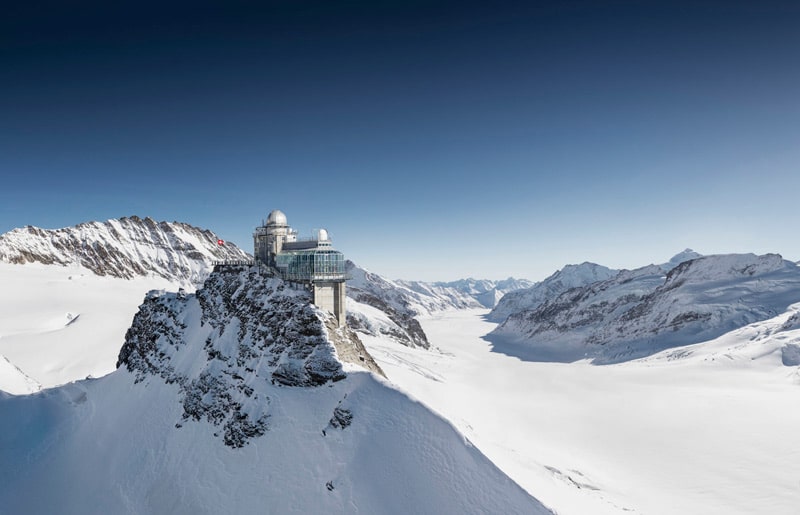
During the summer months the Snow Park is one of the most popular things to do at Jungfraujoch. Here you can try snow tubing (CHF 20 per adult, CHF 15 per child) or sledging (CHF 25/CHF 20) for unlimited rides, skiing or snowboarding (CHF 35/CHF 25) or just play in the snow.
There’s also a flying fox – called the Tyrolienne – (CHF 20 per adult/CHF 15 per child) and golfers can have three attempts at hitting a hole-in-one for just CHF 10.
(All activity prices to be confirmed for 2025.)
At Jungfraujoch Top of Europe you’ll also find a shop selling clothing and souvenirs.
What else should I know about the Jungfraujoch train?
- There are no toilets or food/drink facilities onboard.
- The trains operating on the Jungfraujoch line are wheelchair accessible but you should advise railway staff at your departure point if you are traveling with a passenger in a wheelchair so that someone is ready to assist with changing trains at Kleine Scheidegg.
- The Jungfraujoch service operates 365 days per year.
- The Jungfraujoch railway station is the highest railway station in Europe at 3,454 metres above sea level.
When should I buy the Jungfrau Travel Pass? Worth it or not?

If you are visiting the Jungfrau region of Switzerland and are spending more than one day in the region, and will do a day trip to the Jungfraujoch and at least one additional mountain excursion, the Jungfrau Travel Pass is likely to be the best value travel pass for your trip.
(*Note: Some excursions only begin operating in mid-May or early June).
Below is an example 3-day itinerary so you can decide is the Jungfrau Travel Pass worth it.
> Day 1 – Excursion to Jungfraujoch
Regular Jungfraujoch ticket price = CHF 249.80 return per adult from Interlaken (high season).
Cost with Jungfrau Travel Pass = Free except for supplement for the final journey CHF 75 (high season).
> Day 2 – Excursion to Mürren via the BLM Bergbahn (Lauterbrunnen – Mürren cable car/train) AND Harder Kulm funicular
Regular fare – Interlaken to Lauterbrunnen by train CHF 15.20 + Lauterbrunnen to Mürren by cable car/train CHF23.60 = CHF 38.80 return
Harder Kulm funicular = CHF 44 return
> Day 3 – Excursion to Grindelwald and Mt. First
Regular fare – Interlaken to Grindelwald First cable car station by train and bus CHF 29.60 return + cable car to Mt. First CHF76 (high season) return for the cable car = CHF 105.60
The total cost of the above excursions using regular adult fares is CHF 438.20.
The 3-day Jungfrau Travel Pass costs CHF 265 (CHF 190 plus CHF 75^ for the final sector on the Jungfraujoch). Purchasing the Pass represents a saving of CHF 173.20 per adult for the above excursions.
^Peak season supplement
All prices are based on departing from Interlaken Ost station and are subject to change without warning.
What does Jungfraujoch mean in English?
In case you were wondering, the German word Jungfrau means young lady or virgin, and the word joch translates as pass (as in a mountain pass).
Final Thoughts
The Jungfrau Travel Pass offers excellent value for those who plan to take the excursion to Jungfraujoch and enjoy more sightseeing in the region.
Visitors arriving in the region by car will also benefit from purchasing the Jungfrau Travel Pass as it is only possible to reach the mountain summits by train, cable car or funicular.
The car-free villages of Wengen and Murren can also only be reached by public transport, and these journeys are included with the Jungfrau Travel Pass.
Why not make the most of your time in the Jungfrau Region and explore the mountains, villages and lakes aboard the excellent network of trains, cable cars, funiculars and boats that are covered by the Jungfrau Travel Pass?
Listen to our Jungfrau Railways Podcast Episode
Click here or click the green button below to listen:
SWITZERLAND TRAVEL ESSENTIALS

